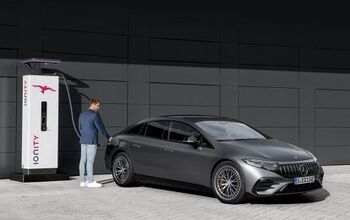Ford CEO Sees a Future for Hands-on Driving, but a New Patent Shows the Company Hedging Its Bets

If you believe certain segments of the media, we’ll soon be able to avoid the drudgery of turning a steering wheel, pressing and releasing pedals, and — gasp! — shifting gears.
The inevitable onset of self-driving vehicles, tech aficionados and urbanists tell us, will bring traffic fatalities down to zero, somehow remove all congestion from the road, and turn our lives into a never-ending sojourn of blissful tranquility. Never again will you take that aimless and unprogrammed late-night drive, just for the hell of it. Never again will you bother with buying and owning a car. Automakers will simply turn their driverless cars loose, emptying driveways while filling streets with hands-off ride-sharing pods.
Not so fast, says Ford’s newly minted CEO.
While Jim Hackett, former chairman of Ford’s mobility arm and successor to former CEO Mark Fields, sees a future in autonomous driving technology and ride-sharing, that’s not the entirety of the vision. People will still want to own cars and, yes, drive them.
Despite going full bore in the mobility direction (Ford bought — and will expand — ridesharing service Chariot and will invest over $1 billion into self-driving tech startup Argo AI), Hackett claims the future isn’t the clear image tech writers make it out to be.
In an interview with SFGate on the eve of Ford’s City of Tomorrow Symposium in San Francisco, Hackett said that as new technologies enter the mainstream, it is “going to be harder to understand why you need [conventional cars].” That certainly sounds like Ford’s on board with the Red Barchetta vision. However, when asked if Ford plans to ditch human-operated cars altogether, Hackett offered mild reassurance to traditionalists.
“We don’t know that autonomous vehicle intelligence in the future will all be delegated to a service that no one owns but everyone uses,” Hackett said. “It could play a role in vehicles that people own, vehicles that aren’t supposed to crash. You’re buying the capability because of the protection it gives you. It’s also possible it could be applied in these big, disruptive ways that of course we’re not blind to, but my bet is we don’t know.”
So, you’ll definitely maybe be able to buy and own a Mustang or F-150 in the future. With its fingers now inserted in many high-tech pies, Ford feels there’s profit to be found even if the future favors the likes of Google and Apple. Still, a robot car-only future isn’t nearly upon us, he claims.
“But the nature of the romanticism by everybody in the media about how this robot works is overextended right now. It will be a progressive thing, just like computing. If you think about a vehicle that can drive anywhere, anytime, in any circumstance, cold, rain — that’s longer than 2021. And every manufacturer will tell you that,” Hackett said.
“Ten years ago, it was about thinking of the vehicle having this independence. I think it’ll be a co-dependent model in the future. Co-dependence will actually create a safe envelope for the vehicles.”
As if to underline those last two sentences, a new Ford patent suggests future vehicles could carry a removable steering wheel and pedals. Inserted into dashboard slots and secured with locking points, the hands-on equipment would give drivers the ability to turn their autonomous cars into good ol’ fashioned jalopies when the mood hits. Sure, the connection’s digital, but at least you’re the boss, right?
Maybe the concept isn’t so hot for some, nay many readers. But the patent, as well as Hackett’s words, show the industry’s biggest automakers remain, if not in the dark, than in the gloomiest shade about what the future holds.
[Image: Ford Motor Company]

More by Steph Willems
Latest Car Reviews
Read moreLatest Product Reviews
Read moreRecent Comments
- Lorenzo I just noticed the 1954 Ford Customline V8 has the same exterior dimensions, but better legroom, shoulder room, hip room, a V8 engine, and a trunk lid. It sold, with Fordomatic, for $21,500, inflation adjusted.
- Lorenzo They won't be sold just in Beverly Hills - there's a Nieman-Marcus in nearly every big city. When they're finally junked, the transfer case will be first to be salvaged, since it'll be unused.
- Ltcmgm78 Just what we need to do: add more EVs that require a charging station! We own a Volt. We charge at home. We bought the Volt off-lease. We're retired and can do all our daily errands without burning any gasoline. For us this works, but we no longer have a work commute.
- Michael S6 Given the choice between the Hornet R/T and the Alfa, I'd pick an Uber.
- Michael S6 Nissan seems to be doing well at the low end of the market with their small cars and cuv. Competitiveness evaporates as you move up to larger size cars and suvs.


































Comments
Join the conversation
Visions of the bloated passengers residing on the starship of the movie Wall-E dancing in my head. While I can see some benefit to autonomous vehicles, I also don't ever want to totally give up the ability to row my own gears, stab the gas pedal and take the twisties with wheel firmly in my own hands.
I just don't envision autonomous cars getting it done in a CNY winter. Steep snowy roads, gauging snow drifts, spotting black ice, and even not getting caught in a shotgun blast from a salt truck. Lots of variables. Lake effect storms can dump a couple of feet with temps remaining well below freezing, the electric models may have range issues. I don't want to get stuck behind a self-driver going 20 in a 55 either.